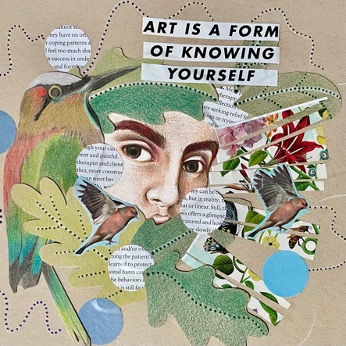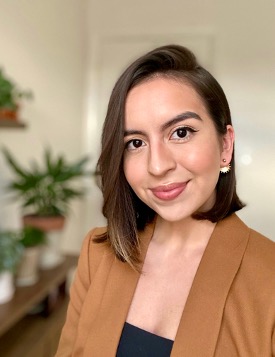The American Art Therapy Association represents a diversity of professionals, students, and organizations across the nation. We recognize and celebrate the work of our members at all levels through our Featured Member series. During National Hispanic Heritage Month 2021 (September 15 – October 15), we are spotlighting members of the Latinx community.
October 21, 2021
How does it feel to be a Hispanic individual and what does it mean to you? How have you used art to honor your culture or heritage?
Hispanic and Latinx Heritage Month represents a time for reflection and admiration for the cultural and ancestral origins of my family. This month, I am reminded of the sacrifices my parents made as young adults in pursuit of freedom and stability for our family. My mother and father fled El Salvador to escape poverty, government corruption, and a devastating civil war. I am reminded of the countless stories my parents have shared with me about the process of navigating adversity, such as cultural and linguistic barriers, in the United States. Their experiences fill me with a sense of gratitude and pride as I reflect on who I am and where I come from.

“A Glimpse into Freedom, Safety, and Resilience,” by Sonia Castro. Mixed Media. September 21, 2021. Artist Statement: In this piece, I explore the various layers of my cultural identity that have sustained and lifted me during my own process of change and healing.
What have your experiences been like doing art therapy with Spanish-speaking populations? Do you think those clients would have had access to art therapy if you weren’t available?
My first experience providing art therapy to a Spanish-speaking client occurred my last year in graduate school when I was a student intern at an inpatient oncology and hematology unit. I encountered many patients and families of diverse backgrounds who reported difficulties communicating their emotional needs in English, even with the use of interpretation services. These pivotal interactions in my profession remain ingrained in my memory, as it sparked a desire to advocate for and on behalf of the Latinx immigrant community and other marginalized groups in the mental health setting.
Through my continued work with Spanish-speaking clients, a pertinent theme that came to light was the stigmatized view of mental health and therapy. I discovered that many of my clients learned to keep mental health concerns private for fear of being shamed or humiliated. I could certainly draw parallels between their cultural experiences and my own. In understanding that this stigma was pervasive in our community, I adapted my approach and started to carefully address the unspoken hesitations that may have been arising in the therapeutic process.
Most of the Spanish-speaking clients I have previously served would not have received art therapy had I not been available due to the lack of Spanish-speaking art therapists in the mental health field. Through the use of art therapy and shared spoken language, I have provided support to clients as they process emotional experiences in a form of expression that felt most comforting to them, whether in a verbal or non-verbal manner.
In what ways does attending a predominantly white institution (PWI) affect your art therapy training? Are their systems in place to address diversity and make transformative changes?
The experience of attending a predominantly white institution allowed me to better acknowledge the similarities and differences between my own lived experiences in contrast to those of my white peers. Through this process, I developed a deeper appreciation for the overlapping and intersecting parts of my identity as a first-generation Latina in the United States. I was fortunate to attend graduate school with a group of peers and professors that openly engaged in dialogue about diversity and inclusion. These candid conversations served me long after graduate school and helped me cultivate courage and humility in my own clinical practice whenever complex racial or cultural themes surfaced with clients.
Is there anything else you would like to share?
It is my hope that as the field of art therapy continues to grow, there will be increased representation of Latinx art therapists in our literature and communities.
Sonia Castro, MA, ATR, RIC
 Sonia Castro is a registered art therapist and artist who provides art therapy and counseling services to children, adolescents, and young adults at a non-profit organization in Virginia. Sonia earned a Master of Arts in Art Therapy from The George Washington University and a Bachelor of Arts in Psychology with a Minor in Fine Arts from George Mason University. Sonia has served culturally and linguistically diverse populations in variety of settings including private practice, intensive in-home therapy, a residential drug and alcohol recovery center, an inpatient oncology/hematology unit, a domestic violence shelter, and a community-based counseling clinic. Sonia is a member of the Virginia Art Therapy Association.
Sonia Castro is a registered art therapist and artist who provides art therapy and counseling services to children, adolescents, and young adults at a non-profit organization in Virginia. Sonia earned a Master of Arts in Art Therapy from The George Washington University and a Bachelor of Arts in Psychology with a Minor in Fine Arts from George Mason University. Sonia has served culturally and linguistically diverse populations in variety of settings including private practice, intensive in-home therapy, a residential drug and alcohol recovery center, an inpatient oncology/hematology unit, a domestic violence shelter, and a community-based counseling clinic. Sonia is a member of the Virginia Art Therapy Association.
